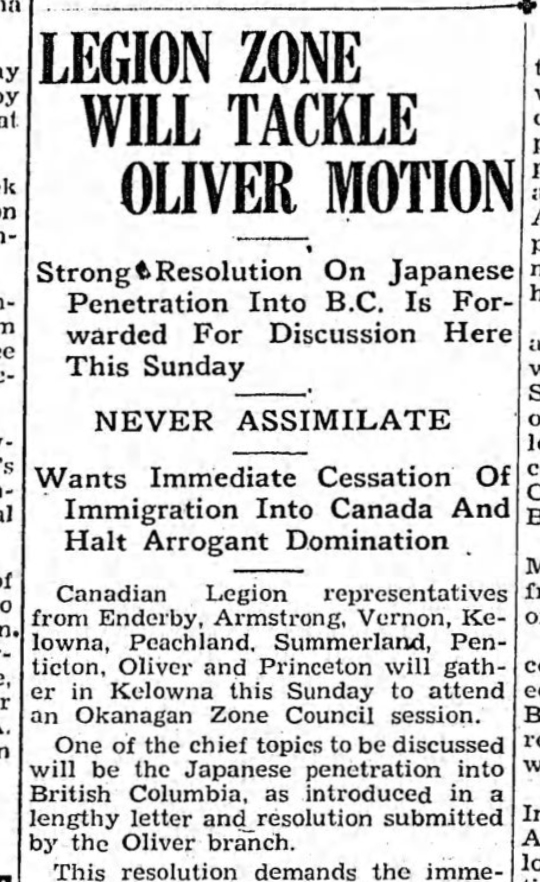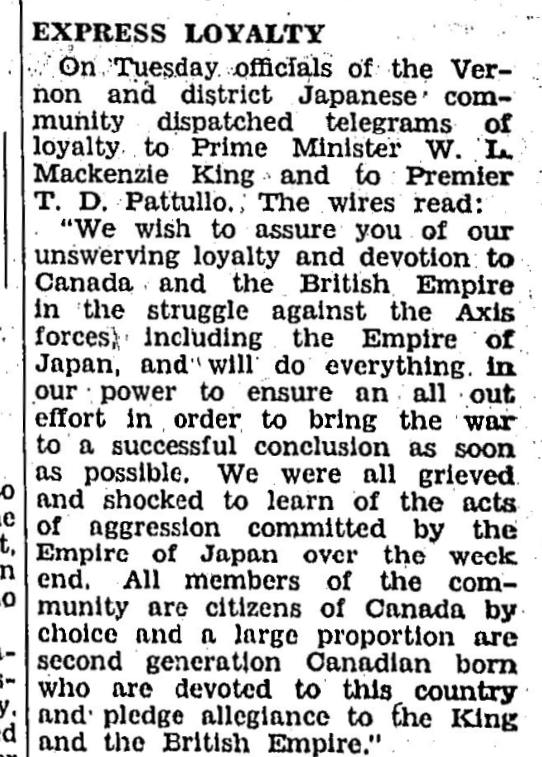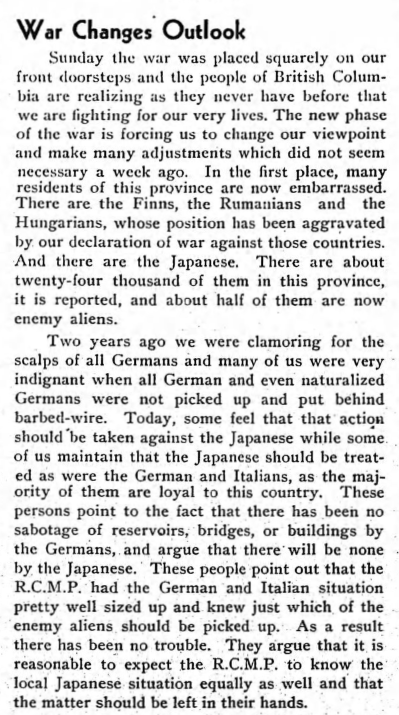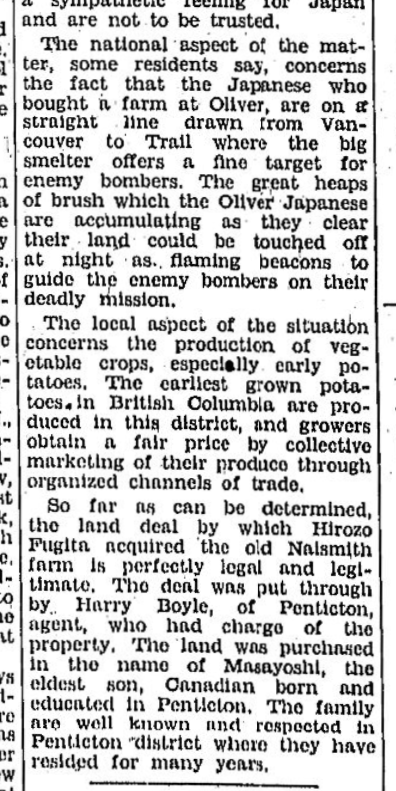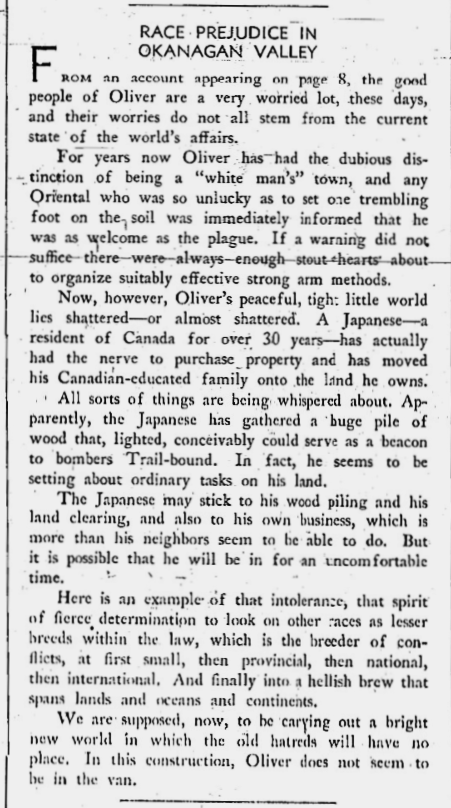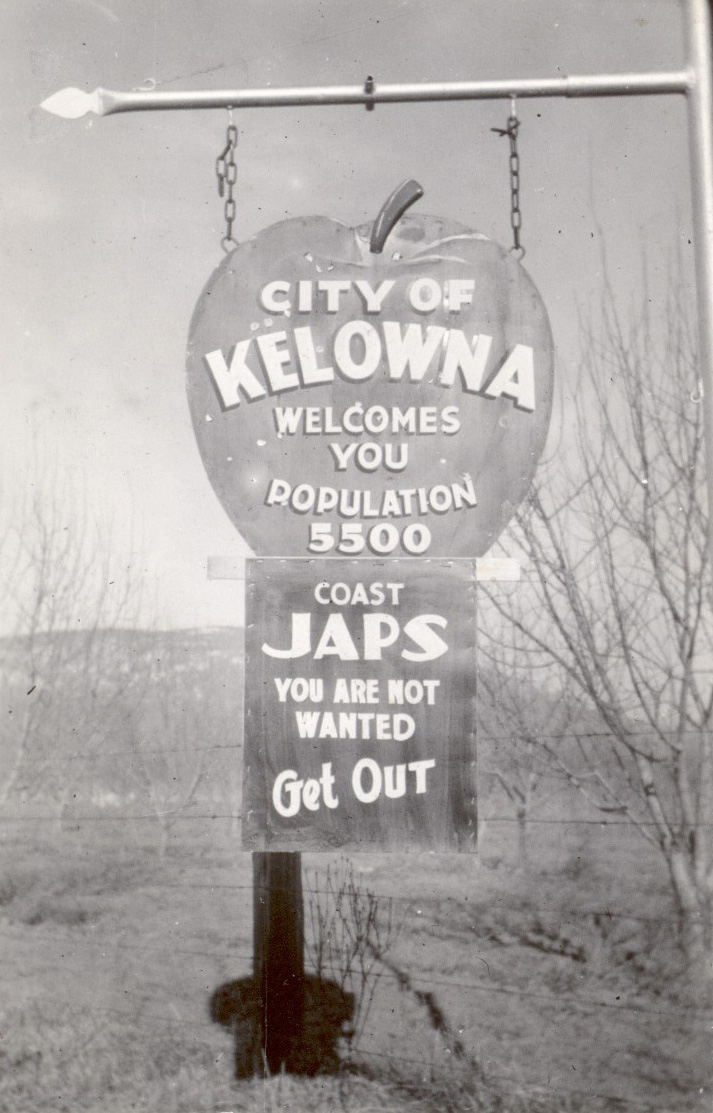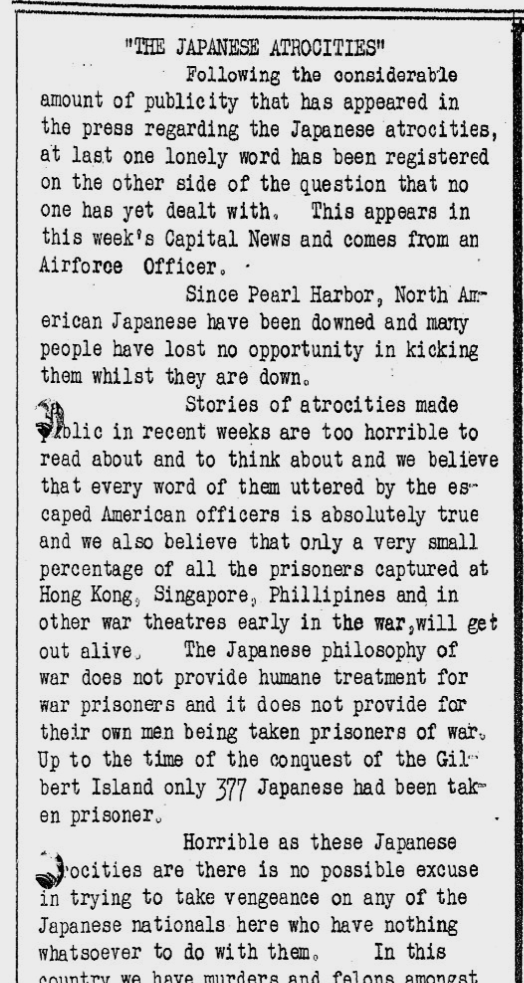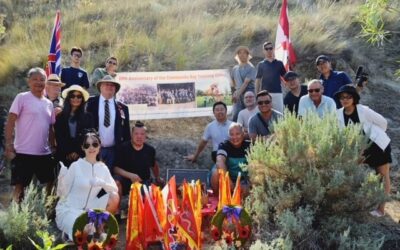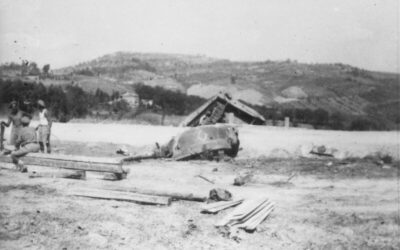Warning. This article may contain themes and language some may find offensive.
Leading up to the start of World War II, British Columbia was gripped by fear of the so-called ‘Oriental Menace.’1 Many believed that Asian immigrants would soon dominate commercial, agricultural, and industrial sectors, fueled by a combination of high birth rates, ongoing immigration, lower wages, and different living standards.2
Clipping from page 5
Kelowna Courier March 10, 1938
During the early decades of the 20th Century, Oliver and Osoyoos were the epicentre of anti-Asian attitudes in the Okanagan when various civic bodies in the Okanagan discussed resolutions like this one to lobby provincial and federal governments to change policies.3
In the Editorial column of the Vernon News, July 17, 1941 under the title ‘Organized Attempt to Smash Marketing,’ it describes how “the energetic Chinese or Japanese family, content with a low standard of living, concentrates on production, knowing they can undersell the white farmer, who must maintain a certain standard of existence.”4 This perception of economic competition, combined with the belief that Asians could not fully assimilate, fueled racist attitudes for decades.
During World War II, labour shortages in Okanagan farms and orchards created tension between rural farmers, who needed workers, and urban residents, who sought to restrict Asian settlement—especially after December 1941. While speculation about Imperial Japan’s war plans was widespread, there was little direct commentary linking British Columbia’s Asian population to the conflict – until the surprise attack on Pearl Harbor on December 7, 1941, abruptly changed the discourse.
Clipping from page 1
Vernon News December 11, 1941
Then came the shock of simultaneous attacks on December 7, 1941, at Pearl Harbor, Hong Kong, Malaya, Singapore, Wake Island, Guam, Philippines, and Thailand.5
Clipping from page 2
Kelowna Courier December 11, 1941
These clippings illustrate the loyalty and challenges the Japanese communities faced after the shock of the attacks by the Imperial Japanese forces in Asia.6
Clipping from page 8
Vernon News Feb. 18, 1941
Hysterics, mocked by an article in Vernon News titled ‘Call out the Army – Sacred Oliver Invaded,’ highlighted the paranoia of the times.7
Clipping from page 14
Vernon News December 18, 1941
Here is an example of the editor of the Vernon News attempting to condemn the town of Oliver.8 However, Oliver wasn’t the only Okanagan town swept up in fear and hysteria. Summerland and Kelowna erected racist signage at their borders and anti- Japanese warnings in the newspapers.9
A ‘Welcome’ sign of the times 1942
Kelowna Public Archives KPA#784
February and March 1942 were very emotional months as communities adapted to the realities of the Pacific War. Various Boards of Trade, agricultural associations, municipal councils and civic groups discussed the so-called ‘Japanese Problem’ while the Dominion Government of Canada through the BC Security Commission initiated property confiscations, forced displacement from the coast and other restrictions upon BC’s Japanese population. Alleged ‘Fifth Columnists,’ or in today’s language ‘insurrectionists’, were expected to rise against Canada and attack water, power, rail, and government infrastructure to undermine the Canadian war efforts. These actions never occurred nor was there evidence of any subversive elements within the Asian communities. Mass meetings were held to address these issues in blunt terms as recorded in the Kelowna Courier March 12 and 19, 1941 editions. 10/11
Clippings from pages 1 and 2
Kelowna Capital News
February 16, 1944
Although the wars in Europe and Asia were still raging, some looked to the future legacy of Canada’s treatment of Japanese and Japanese Canadians by asking if our policies aligned with our national values or with those of the ‘enemy.’
As sentiment shifted toward holding political, military, and economic elites in the soon-to-be-defeated nations accountable for wartime atrocities, there was also a growing recognition that individuals—not entire populations – should bear responsibility for the actions of their leaders. This marked a departure from the punitive measures imposed after World War I in 1919.
Yet, Canada was not done with the so-called ‘Japanese Problem.’ Wartime measures and decrees remained in place until 1949, and it wasn’t until 2012 that the British Columbia government formally apologized.12
Suggested reading:
The Okanagan Valley and World War II: Issues and Reactions to the Japanese and Chinese, by Jesse MacDonald, pg. 57, 73rd Okanagan Historical Report found here:
https://open.library.ubc.ca/viewer/ohs/1.0340368#p58z-3r0F:japanese
The Chinese History of Oliver and Area, by Darryl MacKenzie, pg. 63, 73rd Okanagan Historical Report found here: https://open.library.ubc.ca/viewer/ohs/1.0340368#p64z-3r0f:seventy-third or here: https://www.oliverheritage.ca/history-chinese-history
Landscapes of Injustice https://www.landscapesofinjustice.com/
Reference:
1] Roy, Patricia E. “The Oriental ‘Menace’ in British Columbia.” in Studies in Canadian Social History, edited by Michel Horn and Ronald Saborin. Toronto: McClelland and Stewart, 1974. The term Oriental is an outdated descriptor and is replaced by the term Asian in this discussion.
2] British Columbia, Legislative Assembly, Votes and Proceedings, November 29, 1922, p. 10; December 4, 1922, p. 4; November 16, 1922, p. 10; December 5, 1922, p. 4.
The cases relating to the disallowance of 1922 are cited in H. F. Angus, “The Legal Status in British Columbia of Residents of Oriental Race and Their Descendants,’* The Canadian Bar Review, vol. IX (January 1931), p. 6, n. 34 and 35.
3] Kelowna Courier March 10, 1938, pg5 Legion Zone will tackle Oliver Motion https://bcrdh.ca/islandora/object/news%3A55487#page/4/mode/2up
4] Vernon News July 17, 1941, pg6 Editorial, organizing attempt to smash marketing https://bcrdh.ca/islandora/object/news%3A239873#page/6/mode/2up
5] Vernon News December 11, 1941, pg1 https://bcrdh.ca/islandora/object/news%3A274744#page/1/mode/2up
6] Kelowna Courier December 11, 1941, pg2 https://bcrdh.ca/islandora/object/news%3A57268#page/2/mode/2up
7] Vernon News December 18, 1941, pg8 https://bcrdh.ca/islandora/object/news%3A261243#page/8/mode/2up
8] Vernon News December 18, 1941, pg14 https://bcrdh.ca/islandora/object/news%3A261243#page/14/mode/2up
9] COAST JAPS? The story behind this infamous Kelowna sign from 80 years ago by Jesse Tomas, Infotel News https://infotel.ca/newsitem/coast-japs-the-story-behind-this-infamous-kelowna-sign-from-80-years-ago/it107082#:~:text=An%20archived%20article%20in%20the,article%20about%20the%20racist%20signs; Summerland museum shares a look at a dark day in local history with racial discrimination https://www.castanet.net/news/Penticton/478410/Summerland-museum-shares-a-look-at-a-dark-day-in-local-history-with-racial-discrimination
10] Kelowna Courier February 12, 1942, pg1 three articles on the front page https://bcrdh.ca/islandora/object/news%3A57681#page/1/mode/2up; https://bcrdh.ca/islandora/object/news%3A57681#page/10/mode/2up
11] Kelowna Courier March 19, 1942, pgs1, 8 ‘Here is Okanagan’s case against Japanese settlement’ by RG Rutherford regional representative of Advisory Board to the Dominion Security Commission [aka BC Security Commission] https://bcrdh.ca/islandora/object/news%3A57692#page/8/mode/2up
12] Transcript of the apology by the Government of BC for Japanese Canadian internment during World War II, May 7, 2021 https://www.vncs.ca/b-c-government-apologizes-for-interment-of-japanese-canadians-in-1942/

